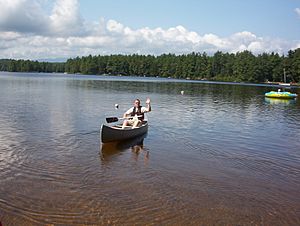Conway Lake facts for kids
Quick facts for kids Conway Lake |
|
|---|---|

Conway Lake in summer
|
|
| Location | Carroll County, New Hampshire |
| Coordinates | 43°57′45″N 71°03′28″W / 43.96250°N 71.05778°W |
| Lake type | Natural w/ dam |
| Primary inflows | Snow Brook |
| Primary outflows | Mill Brook |
| Basin countries | United States |
| Max. length | 4.0 mi (6.4 km) |
| Max. width | 1.4 mi (2.3 km) |
| Surface area | 1,316 acres (5 km2) |
| Average depth | 15 ft (4.6 m) |
| Max. depth | 45 ft (14 m) |
| Shore length1 | 19.2 miles (30.9 km) |
| Surface elevation | 437 ft (133 m) |
| Settlements | Conway; Eaton |
| 1 Shore length is not a well-defined measure. | |
Conway Lake is a beautiful body of water in eastern New Hampshire, in the United States. It covers about 1,316 acres (5.3 km²) and is up to 45 feet (14 m) deep. You can find it in Carroll County, within the towns of Conway and Eaton. The lake sits just east of the famous White Mountains and is part of the Saco River system.
Contents
History of Conway Lake
Conway Lake used to be known as Walker's Pond. At the northern end of the lake, on Mill Street, there is a park. This park includes the Conway Lake Dam and the place where old mills once stood.
In 1773, Captain Timothy Walker was given 100 acres (40 ha) of land by the town of Conway. He used this land to build a sawmill, which cuts wood, and a gristmill, which grinds grain. Later, the mill was sold to H. B. Cotton, who started making boxes and parts for pianos. Henry Peary was the last owner of the mill. Sadly, it burned down and was never rebuilt. This was a big loss for the town's economy.
In 1817, a book called Gazetteer of the State of New Hampshire described Conway. It said the town had four mills for corn, five sawmills, a mill for dressing cloth, two machines for carding (preparing wool), three places for making alcohol, and three stores.
The mills really started to do well after train tracks arrived in 1865. Logs were floated across Conway Lake to be processed. Then, they were loaded onto freight cars and sent to places like Portsmouth. The mills on Mill Street, along with granite from nearby Redstone, helped build several train stations in New England.
A public beach was added to the lake in 1952. The land for the beach was given to the town by the Public Service Company of New Hampshire. The town raised $100 to make the beach better. Because the public beach was so popular, the town soon added a place for boats to launch.
Interesting old items from the Sokoki Indian people have been found around the lake. George Chapman found some of these artifacts around 1965. They were discovered in what was once a Sokoki village on the north shore of the lake.
Fish You Can Find in Conway Lake
Conway Lake is home to several kinds of freshwater fish. These include:
- Chain pickerel
- Hornpout (also known as brown bullhead)
- Landlocked salmon
- Largemouth bass
- Rainbow trout
- Smallmouth bass
The New Hampshire Fish and Game Department helps manage the lake, especially for landlocked salmon. If you want to fish here, you need a fishing license. The lake waters are checked regularly to make sure everyone follows the rules.
How People Use Conway Lake
For many years, Conway Lake has been a popular spot for fun activities. There is one public beach located off Mill Street in Conway. People enjoy coming to the lake for:
- Swimming
- Boating
- Canoeing
- Fishing
Wildlife Around the Lake
Conway Lake is also home to many different animals. You might see:
- Herons
- Loons
- Eagles
- Deer
- Snakes
- Stinkpot turtles
- Painted turtles
- Snapping turtles



